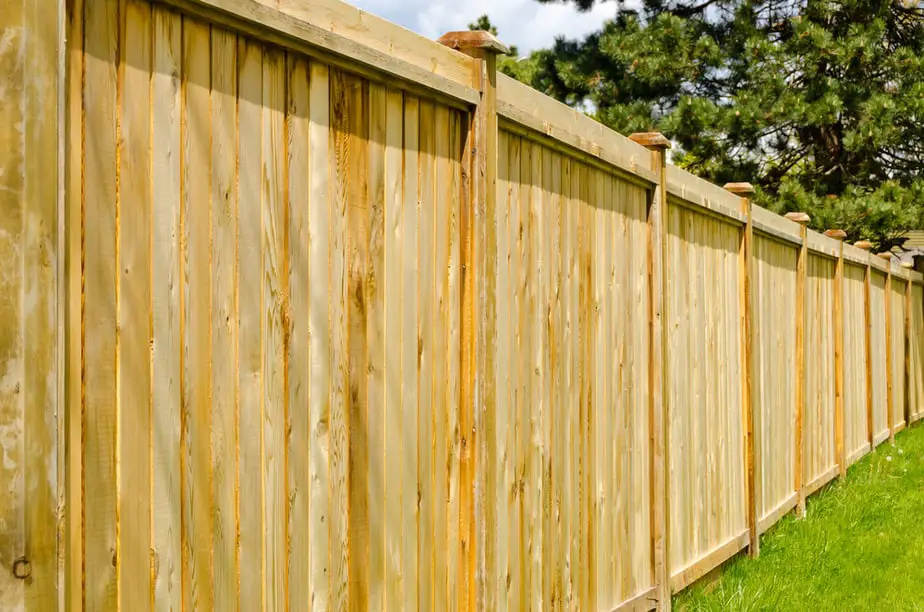Wood fences can look beautiful, give you privacy and keep your home safe, but how long does a wood fence last? It sounds like a simple question, but there are many factors to consider, including the type of wood you use, the environment your wood fence is in, and how well it is maintained.

Here, we take a look at some of the variables to consider when working out the expected life of your wooden fence.
Table of Contents
Choosing a Wood for Your Fence
The type of fence wood you use plays a big part in how long your wood fence will last. If a fence is made of poor quality wood and not looked after it could last less than five years, but if it is made out of good quality wood and properly maintained, your fence could still be standing after 100 years!
Although relatively expensive, cedar and redwood are particularly strong and are more resistant to rot and decay than other types of wood. You should expect a wooden fence made out of cedar or redwood to last at least 15 years, and even longer if the fence is well looked after.
Another popular material when selecting wood for fencing is pressure-treated pine. It is much cheaper than cedar or redwood, but the fence tends to last about half as long as this type of wood is less resistant to decay. If the pine is repainted or re-stained regularly, though, this can greatly extend its life span. It is common for fences to use pressure-treated pine for posts (as they handle exposure to soil better) and the more expensive cedar for the palings.
Spruce is another option if you are on a strict budget, and a fence made out of this wood should last around seven years. Spruce is light-colored, so it is easy to paint. If you decide not to paint, then over time, it becomes an appealing dark grey.
How to Prevent Your Wood Fence From Rotting
As your wooden fence is constantly exposed to the elements, the likelihood of getting rot is high. But thankfully, there are things you can do to lessen the risk.
There are two types of rot that can damage your wood fences – wet rot and dry rot – and your fence is likely to be more susceptible to one than the other.
Wet rot occurs when the timber is in constant contact with moisture such as rain, snow, or even lawn sprinklers. This causes the timber to crack and soften. It also encourages fungus to grow, which then produces an unpleasant musty smell.
Dry rot occurs when the fence is in a harsh, dry environment and has constant exposure to sun or hot winds. Even if you have used a protective oil, as the oil starts to disappear, your wood can become brittle and break easily.
One way to reduce rot is to use concrete or gravel filler in your post holes to prevent moisture from creeping up to where the fence post touches the ground. You should also ensure that wherever possible, your sprinkler is not spraying water directly onto your fence.
You should also keep leaves, grass, and other debris away from your fence line, as these tend to trap moisture, which will cause your wood to rot faster. And even though a vine may look attractive on your fence, this can also attract moisture, and the weight can cause other damage to your fence.
If you are using wood that needs staining, make sure you re-stain your fence regularly as this protects it from the sun, heat, and humidity, and as well as from the rain. A tip for knowing when it’s time to re-stain is to spray a small amount of water on your fence post. If the water creates a bead on the exterior, all is good, but if it is absorbed into the wood, it’s time to reapply the stainer.
How to Extend The Life Of Your Wooden Fence
In addition to taking measures to minimize rotting, there are several other ways you can make sure your wooden fence lasts longer.
When you first install it, unless you know what you are doing, it is worth getting an expert to do the job. They can advise you on the best materials to use, taking into account your particular situation. Appropriate measures are taken upfront to give your fence the greatest chance of a long life! Using the cheapest materials in the installation phase, won’t always save you money in the long run.
It’s also worth keeping your fence well-maintained. For example, if you discover rot in your fence post early enough, you can replace just the fence post rather than getting a whole new fence. And if you stain and paint your fence initially, it is likely to need a repaint every four years and a re-stain every two years.
As much as we love our pets, they can also cause damage to fences. If your dog is prone to scratching fence posts or digging holes, you can add a layer of chicken wire around the base of your fence. This will have the added advantage of keeping your pets safe, too.
Final Thoughts
Often, the more you spend on your fence, the longer it will last. If you are only planning to stay in your house short term, having a fence that lasts for 50 years may not be as important. But if you are creating a family home that you want to pass down the generations, getting a high-quality fence is worth the investment. If you look after your wood fence properly, it should be something you can enjoy for many years to come.